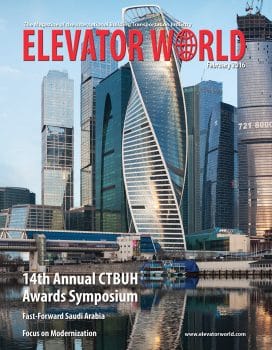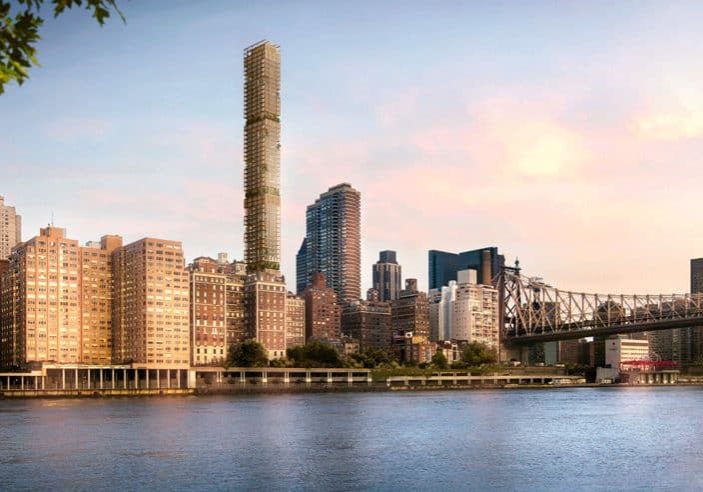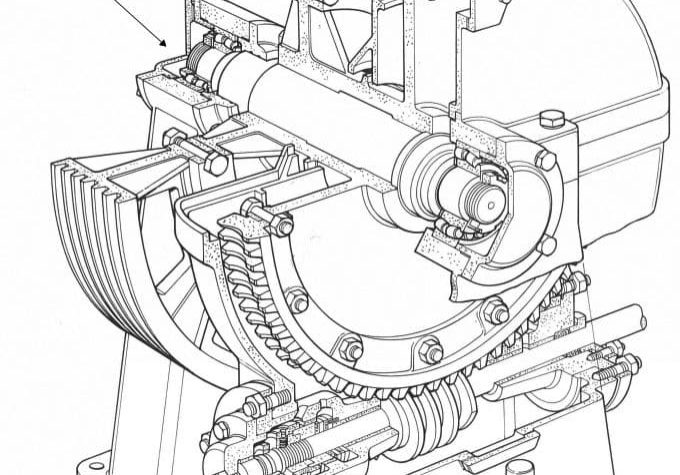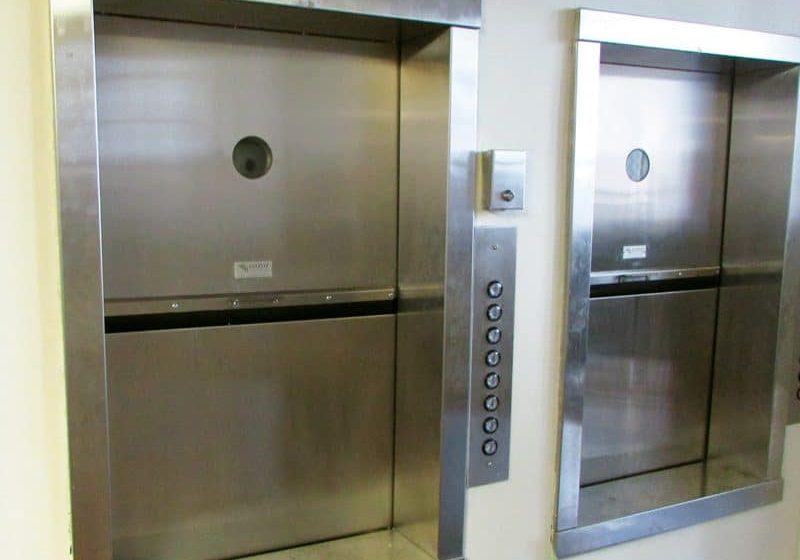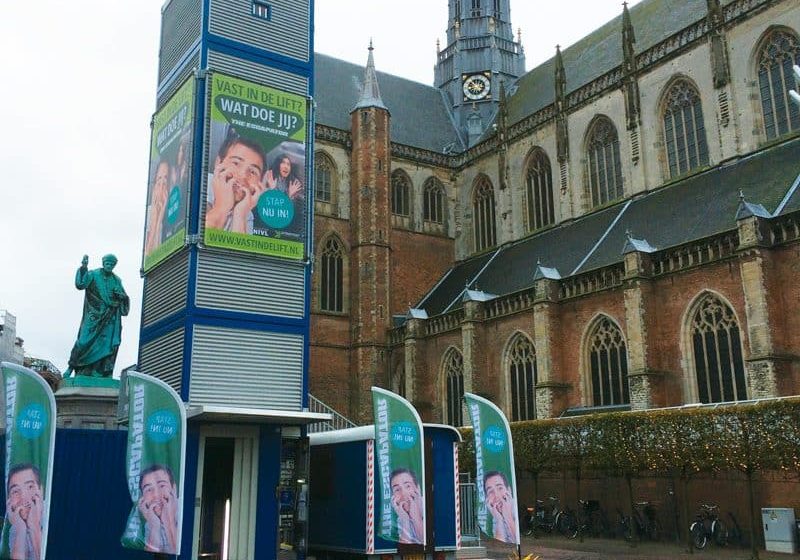Economically progressive kingdom is a standout among Middle Eastern vertical-transportation markets.
Although a looming financial crisis has cast a pall of worry over Saudi Arabia, the kingdom has traditionally been known for its economically progressive policies. With several “world’s largest” projects in the works, it draws people from all over the globe from a vast array of industries. Those in the vertical-transportation industry are no exception. Despite fierce competition and geographical challenges, companies find it pays to invest in Saudi Arabia. The past few years have seen them expand partnerships, open new offices and train and hire additional employees to keep up with demand fueled by residential, commercial and infrastructure projects.
The big OEMs, along with hundreds of smaller companies, employ thousands of people in the kingdom, which has enjoyed significant growth thanks in part to the social and economic initiatives put in place by King Abdallah, who passed away in 2015. His successor, King Salman, appears to be continuing the trend by taking decisive action – such as replacing ineffective leaders and putting incentives in place – to address a severe housing shortage, most notably in Riyadh, the kingdom’s capital and largest city with a population of more than four million.[1]
Those who do business in Saudi Arabia are keeping a wary eye on oil prices (which reached extreme lows in the waning months of 2015), but efforts on the part of kingdom authorities to reduce reliance on oil are paying off: in 2015, 5.4% growth of nonoil Gross Domestic Product (GDP) was a big contributor to anticipated GDP growth of 4.3%. Construction is the main beneficiary, anticipated to grow at an annual rate of 6%.[1]
Cranes dot the dusty skylines of Riyadh, Jeddah, Mecca and Medina. Elevator companies are playing integral roles in projects that have captivated the world’s attention because of their singular grandeur. There is the Jeddah Tower (formerly Kingdom Tower) currently reaching past the 26th floor overlooking the Red Sea.
The centerpiece of mixed-use, multiple-building Jeddah City, the tower in 2015 secured US$2.2 billion in funding and, when completed, would be 1 km tall and surpass current world’s tallest, the Burj Khalifa in Dubai, by more than 560 ft. KONE has been tapped to provide nearly 70 units, including the world’s fastest double-deck elevators traveling at 10 mps, for Jeddah Tower that will utilize its new, lightweight UltraRopeTM, which enables elevator travel up to 1 km.
Even before UltraRope, KONE technology was being applied in Saudi Arabia. Among ambitious projects it handled was the Headquarters Business Park (HBP) in Jeddah, to which it delivered a complete vertical-transportation system in 2014. Consisting of 52- and 13-story towers, HBP presented logistical challenges due to location and land dimensions, Project Manager Mohammed Odeh notes. There was also a tight construction timeline, which KONE met by utilizing a pair of construction time use elevators during construction that were ultimately converted into permanent units. Along with a service package, KONE delivered to HBP:
- 13 MiniSpaceTM elevators
- 18 MonoSpace® elevators
- Two TransitMasterTM 120 escalators
- The PolarisTM destination-control system
- The E-Link remote-monitoring system
Otis supplied vertical-transportation equipment for Burj Khalifa, including, according to Otis, an Otis elevator with the longest travel distance in the world at the time (504 m), the world’s highest elevator landing at 638 m and the world’s fastest double-deck elevators traveling at 10 mps. Global elevator companies aim for such Saudi Arabian developments to continue to serve as showcases for their latest technologies.
Some of the most luxurious developments in the world are found in Saudi Arabia. The Ritz-Carlton, Riyadh was modeled after royal Arabian palaces and is the epitome of elegance. Schindler is among companies that contracted with the hotel developer on that project.
Then, there is the King Abdullah Financial District (KAFD) in Riyadh, essentially a city in itself. Nader Antar, managing director for Otis & UTC Climate, Controls & Security, Saudi Arabia, observes:
“[KAFD] is designed to be the world’s first newly developed major financial district of the 21st century, and represents the latest stage in a carefully planned and implemented program of financial modernization by Saudi Arabia. Two of the tallest structures in the district, the KAFD World Trade Centre and Gulf Cooperation Council (GCC) Bank Headquarters (the Persian Gulf region’s governing financial institution), include Otis elevators and escalators. Otis will install 25 elevators and eight escalators in the KAFD World Trade Centre and 30 elevators and four escalators in the GCC Bank Headquarters.”
In all, Otis is supplying and installing nearly 450 elevators, including 10 double-deck elevators and 112 escalators in various buildings throughout the KAFD. Antar notes the double-deck elevators will play a “critical” role at both the KAFD World Trade Center (WTC) and GCC Bank Headquarters buildings. He elaborates:
“Double-deck elevators save space in a building, allowing room that would otherwise be needed for elevator use to be used as rentable space. Depending on the building and its needs, double-deck elevators can save up to 40% of the space required by traditional elevators, while increasing transportation capacity by 30%. In addition, Otis double-deck elevators enable building developers to create their tallest structures with a more limited ground-level footprint.
“At 300 m tall, the KAFD WTC will include four amenity levels centered on the Otis double-deck elevators. At GCC Bank Headquarters, the building’s functional and spatial arrangements have been carefully considered to support the business activities of its occupier. Three sky lobbies, accessed by double-deck elevators, will ensure amenity floors are easily reached from any of the tower’s 53 stories.”
Otis plans to hand over the WTC and bank headquarters units in the fourth quarter of 2016.
Otis Saudi Arabia won contracts to supply equipment to numerous mega projects in 2015, most notably the Abraj Kudai being built in Mecca. Slated for completion in 2017, it will be the largest hotel in the world with 10,000 rooms in 12 45-story-tall towers. Otis has not yet released details about the order but observes all models will be “designed with Otis ReGenTM regenerative drives, which reduce energy consumption by up to 75% compared with elevators with conventional drives.” These are also prevalent in Burj Khalifa.
Vertical-transportation engineers and others are going above and beyond to overcome challenges and meet clients’ demands in Saudi Arabia, from highly customized vertical-transportation systems to tight construction schedules to geological issues. The hard work is rewarding, and they are optimistic. Antar states:
“The construction industry in Saudi Arabia has shown significant growth over the past few years, fueled mainly by transportation, education and housing projects, as well as rising new mega projects across the kingdom. As a result, there has been an increased demand for low- to mid-rise elevators, the common requirement for these sectors. Market research confirms a continuation of this trend over the next several years. However, we are monitoring continued low oil prices closely.
“Over the next five-10 years, we see a growing potential for the service industry, considering the existing installed base, which is large. Also, government and mega projects will continue to provide potential growth for new-equipment sales.”
Otis established a presence in the kingdom in 1973 and has headquarters in Jeddah. In 2015, Otis parent United Technologies expanded its partnership with E.A. Juffali & Brothers (considered Saudi Arabia’s largest commercial enterprise) to include the sales and servicing of Otis units across the kingdom. Today, Otis has more than 600 employees in Saudi Arabia located in 10 cities.
KONE, which has had a presence in Saudi Arabia since the mid 1980s, strengthened its stake in the kingdom in 2014 with the acquisition of an additional 10% of the OEM’s regional brand KONE Areeco, bringing its share to 50%. It has approximately 750 employees in offices in Abha, Dammam, Medina, Mecca, Riyadh and Jeddah.
thyssenkrupp established itself in Saudi Arabia in 1985 and maintains headquarters in Riyadh with branches in Jeddah, Medina, Mecca and Al Khobar. It has approximately 350 employees and anticipates opening new offices and hiring additional people over the next several years.
Because they are so complex and unique, Saudi Arabian projects make frequent appearances as ELEVATOR WORLD Project of the Year (PoY) winners: This year’s PoY first-place winner in the Moving Walks category was the Prince Mohammed Bin Abdulaziz International Airport in Medina, where thyssenkrupp Elevator applied its unique modular iwalk moving walks which, unlike conventional units, can be installed directly on existing floors with no additional construction required. In 2015, the company won first place for its stairlift in the Makkah Clock Tower in Mecca. Abdul Hamid El Ayoubi, CEO of thyssenkrupp Elevator Middle East, opines:
“Saudi Arabia is currently the biggest market in the region, which makes it very attractive for global and local players alike. Competition is, therefore, ever growing, as are our clients’ requirements. As with other countries in the Gulf, the local market operates in a very diverse environment, both culturally and in its business practices.”
While which sector is driving business varies depending on the company, Otis reports that residential has displayed consistent strength. Today, residential work accounts for more than half of Otis’ Saudi Arabian portfolio, with the rest divided among commercial, high-rise and infrastructure development.
KONE and thyssenkrupp report different breakdowns, with KONE observing that only 15% of its business is residential, with mega and infrastructure projects claiming a heftier share. For thyssenkrupp, projects promoted by local governmental authorities and ministries make up a significant portion of elevator contracts, particularly ones related to infrastructure, healthcare and education. Residential is also a significant driver for thyssenkrupp.
Residential being a major source of work reflects a continued demand for housing driven by a changing industry landscape and favorable policy network, according to Mohamed Iqbal, EW correspondent and managing director for Toshiba Elevator Middle East. He notes that data from the Ministry of Economy and Planning’s 8th Development Plan (2005-2009) stated there was a shortage of nearly 270,000 housing units by the end of the Seventh Development Plan and that the demand was expected to double by 2015. Further, Iqbal states:
“Demand levels in the industry will remain intact due to the continued massive shortage in affordable housing. In fact, we have found that the housing construction industry is expected to overtake other sections in terms of contribution to GDP growth in the coming few years. The forecast is based on the correlation between past market growth in base drivers, such as household size, disposable income, GDP growth and long-term interest rates, competitive structure, government support, contribution by housing financing industries and growing industrialization.”
Toshiba has been active in Saudi Arabia for three years and, in partnership with local distributor Al-Futtaim Engineering Technology, achieved significant market penetration, Iqbal notes. Toshiba’s projects include:
- DAMAC Exclusiva, a 150-m-tall luxury hotel and apartment tower boasting views of Kingdom Tower in Riyadh: equipment includes eight 5-6-mps passenger and two 2.5 mps service elevators serving 34 stops and one machine-room-less (MRL) unit serving the retail portion of the project.
- Rafal Residence, a 28-story apartment development in north Riyadh near the KAFD: equipment includes seven overhead traction elevators with a maximum capacity of 1800 kg and top speed of 3 mps, and three MRL units with a maximum speed of 1.75 mps.
- Sharafi Mega City, a commercial and residential development anchored by an IKEA store: equipment includes 48 1.75 mps elevators with a maximum of 23 stops and 38 escalators with a maximum rise of 6 m.
- Jabal Omar Project, Phase 4, consisting of three podiums and seven hotel towers with a total buildup of approximately 320,000 m2 near the Grand Mosque in Mecca, part of a larger 37-tower development: being delivered over a three-year period that concludes in January 2017, the order consists of 23 outdoor, 30 MRL and 42 high-speed “EL-Bright” elevators traveling at 5 mps and making a maximum of 21 stops. In addition, it includes 38 Elcosmo Series elevators traveling a 2-3 mps and serving up to 30 stops.
Iqbal notes that Saudi Arabia’s western city of Medina has projects in the works totaling approximately US$122 billion as it endeavors to expand the Prophet’s Mosque. He concurs with his colleagues it is a good time to do business in the kingdom.
In light of ever-growing opportunity, Otis intends to put greater focus on workforce training as it expands its presence. Antar observes it is a win/win situation, stating:
“Operating in Saudi Arabia offers large-scale and high growth potential to any business. High-volume orders allow for lower production costs at our factories, while maintaining the highest quality and providing solid service for the future.”
About Saudi Arabia[2&3]
Saudi Arabia is the birthplace of Islam and home to Islam’s two holiest shrines in Medina and Mecca. The modern Saudi state was founded in 1932 by Abd al-Aziz bin Abd al-Rahman al Saud after a 30-year campaign to unify most of the peninsula. One of his male descendants rules the country to this day, as required by law. The majority of the population is Sunni Muslim and, though other faiths are accepted (more than 30% of the population is made up of expatriates of various religions), non-Muslim places of worship are not permitted. Women were permitted to vote and hold office in municipalities for the first time in 2015, with at least 18 women elected to their municipal councils. The country holds approximately 16% of the world’s proven oil reserves, and the government continues to pursue diversification and promote foreign investment.
- Location: Bordering the Persian Gulf and the Red Sea, north of Yemen
- Total area: 2,149,690 km2 (all land, no water), slightly more than one-fifth the size of the U.S.
- Population: 27.75 million, including 6.195 million in Riyadh, 4.076 million in Jeddah, 1.771 million in Mecca, 1.28 million in Medina and 1 million in Dammam
- Per-capita GDP: US$52,300*
- GDP makeup: 57% industry, 41.1% services and 1.9% agriculture
- Labor Force: 11.22 million (approximately 80% are non national)
- Unemployment rate: 11.6%
*Figure calculated using purchasing power parity, which takes into account a greater range of goods than GDP.
References
[1] Yazad Darasha, “Riyadh Rising: Housing demand continues to outstrip supply,” The Arab Weekly, May 1, 2015.
[2] CIA World Factbook (cia.gov/library/publications/the-world-factbook/geos/sa.html).
[3] “Saudi Arabia elects its first female politicians,” Al Jazeera, December 14, 2015.
Get more of Elevator World. Sign up for our free e-newsletter.


